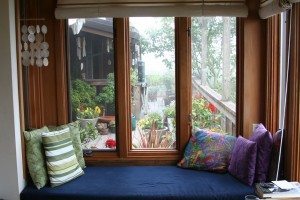One wing down
By Phila Rogers
When I fell and broke my right shoulder in April, I felt as if I had lost a wing. With the arm immobilized in a sling, my balance was compromised. I was deprived of my ability to walk safely which meant no bird walks – a loss not willingly accepted during the most active time of year for most birds. So I took to my bed. Not the bed, exactly, but the narrow daybed in my sunroom which has a fine view of the hanging feeder and seed tray on the adjoining deck.
I became a student of avian minutia. Before long I could distinguish with confidence the difference between a male House Finch and a Purple Finch. Voices helped, too, as there’s no mistaking the melodic Purple Finch’s warbling from the hyperactive, somewhat scratchy House Finch song.

Because it’s breeding season, some birds came in threes. Three Oak Titmice visited daily. I love this plain gray-brown bird with a jaunty crest and a round black eye. A junco pair brought their offspring with its striped breast, the stripes fading in a few days. After a long absence a Chestnut-backed Chickadee family (two adults, three juveniles) descended from the oak tree to the hanging feeder — the young, by instinct, doing a brief wing flutter when the adults were close by. Lesser Goldfinches were frequent visitors, but no amount of careful looking helped me to distinguish the members of the energetic clan by plumage alone. No two looked alike.
And then there was an exciting surprise with the arrival of a brilliant male Black-headed Grosbeak whom I had never seen before at my feeders. He was joined from time to time by two rather drab birds, either females or juvenile birds. Once I watched the male feeding, while from his throat came a soto voce warble.


The larger, mostly brown birds frequented the millet seed saucer — that faithful regular, the California Towhee, and the Mourning Dove, with occasional juncos mixed in.
I learned that mealtime is not a relaxing event for the avian world, with more time spent scanning the surroundings than enjoying a snack. Grab a bite, look up and down, always on guard. The arrival of a Western Scrub Jay caused everyone to flee. A towhee, reluctant to leave, was chased round and round the deck until it evaded a possible attack by ducking between two pots.

In spite of their association with peace and love, the doves reveal a belligerent nature. When the jay arrives on its long, springy legs, rather than always fleeing, a dove may stand its ground (off to one side), puff up to a more impressive size, and pull down its head into its fluffed feather. Or if retreat is required, a dove will fly off on its “whinning” wings which never fail to startle. Among its own kind, doves elbow each other out of the way, or give chase.
So far the local Cooper’s Hawk hasn’t shown up during my watch, but earlier observations say that this is a real deck disperser. Song birds remain in hiding, unmoving and silent, until the first, bravest bird feels it’s safe to return.
After six weeks, deck watching began to pall and I felt the need to visit the nearby canyon with its stream and tangle of verdant vegetation where the migrant singers have built their nests. On the strong arm of my birding buddy Sylvia Hawley, I walked deep into the U.C. Botanical Garden. At a picnic table in a grove of white-barked birch, I drenched my senses in the lilting Warbling Vireo song and the glorious flute-like song of the Swainson’s Thrush.
Liberated from my sling and exercising caution, I look forward to more days in the field, while always remembering the pleasures to be had close to home.

